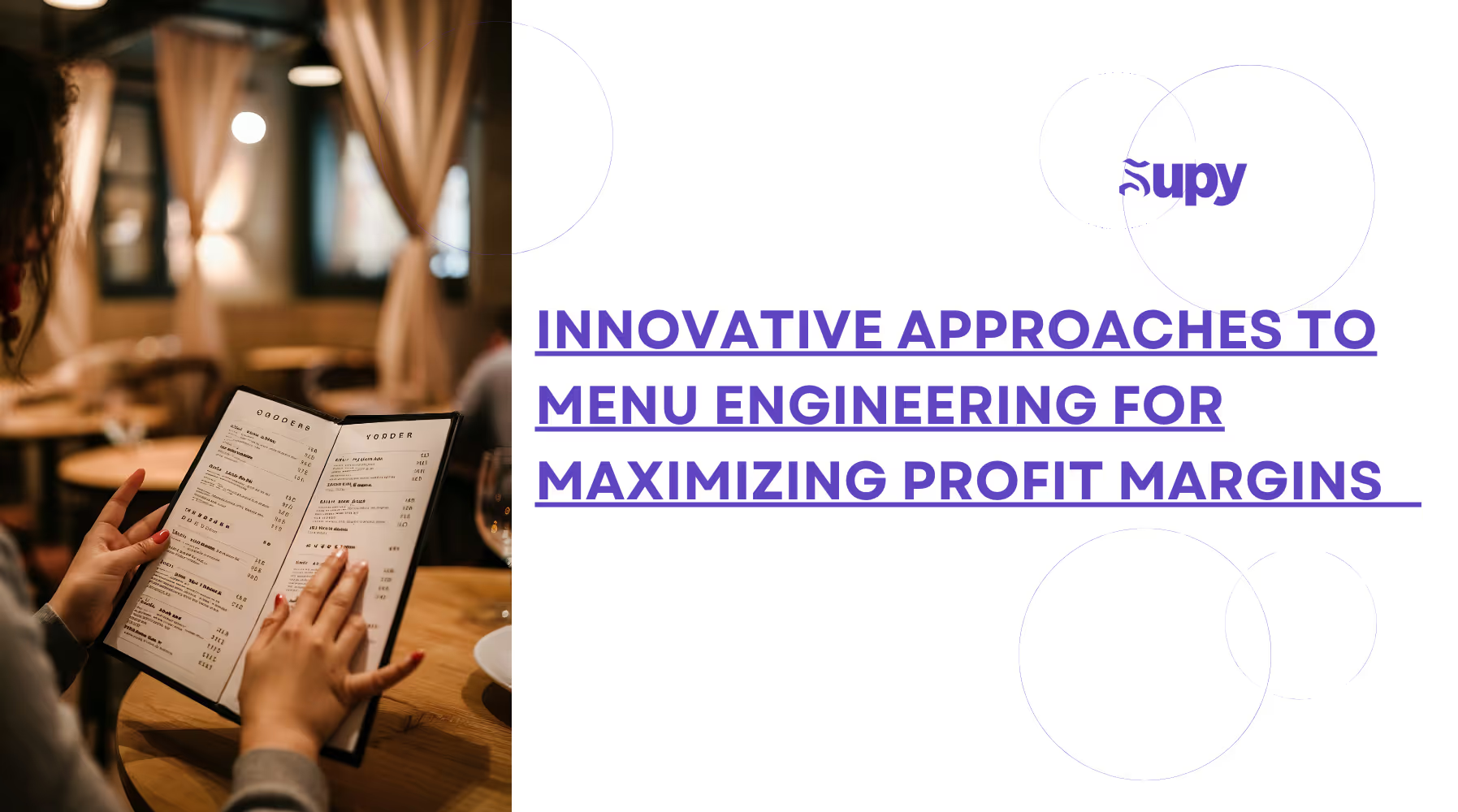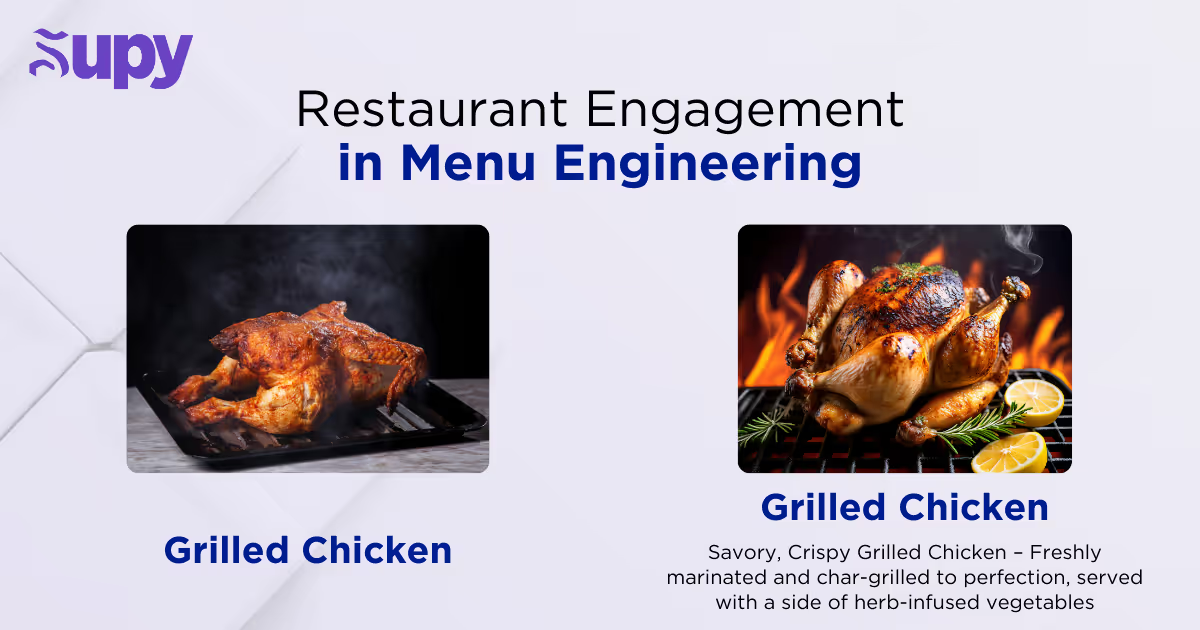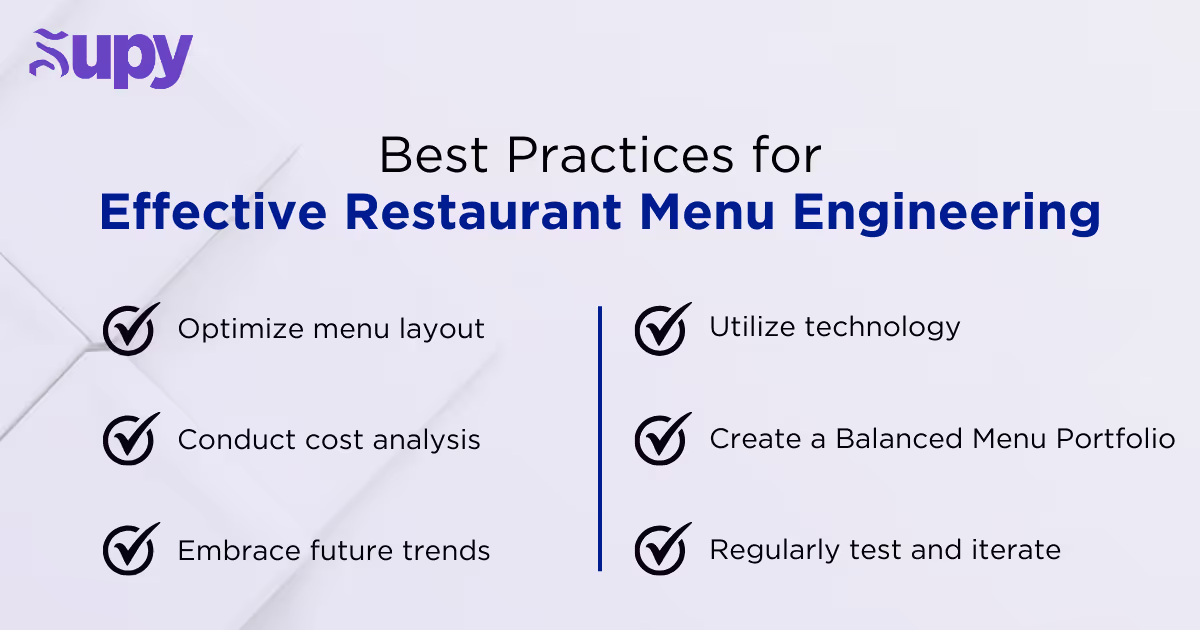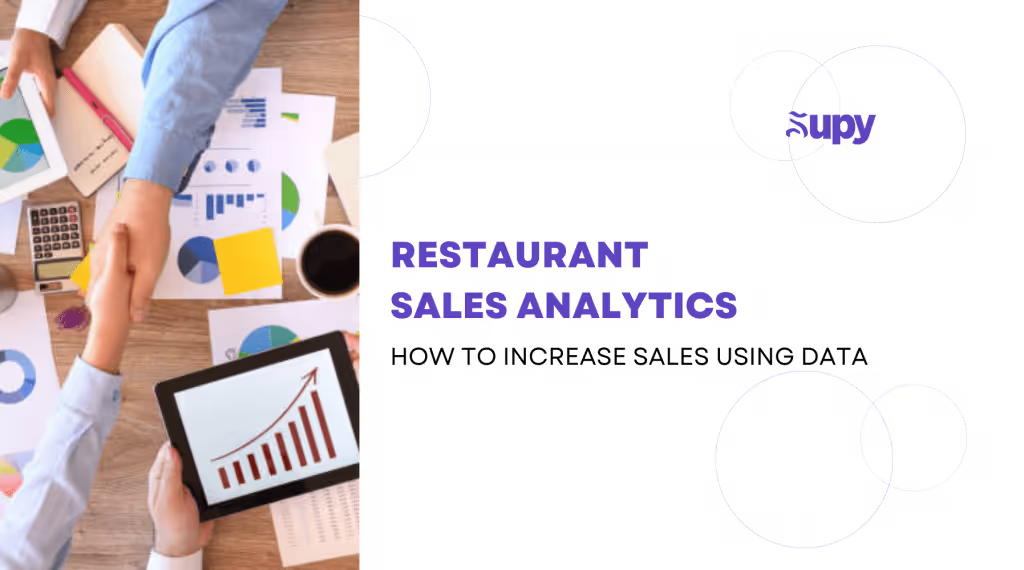Innovative Approaches to Menu Engineering for Maximizing Profit Margins

A well-engineered menu can significantly impact a restaurant's profitability. Research indicates that effective menu design can boost profits by up to 15%, underscoring the importance of strategic menu planning. Menu engineering, which combines psychology, marketing, and operational strategy, helps restaurants understand the profitability and popularity of dishes to maximize revenue.
While many restaurants focus on creativity and culinary excellence, integrating menu engineering into your strategy can drive higher profits, improve customer satisfaction, and streamline operations.
In this blog, we'll cover:
- What is Menu Engineering?
- What is The Profit-Popularity Matrix?
- The Power of Menu Psychology in Menu Engineering
- What Role Does Data Play in Menu Design?
- Online Menu Engineering in the Digital Age
- Best Practices for Effective Restaurant Menu Engineering
- Conclusion
- About Supy
Explore how a thoughtfully designed menu can become a powerful tool in driving your restaurant’s success.
1. What is Menu Engineering?

Menu engineering is a strategic process that focuses on maximizing the profitability and popularity of menu items. By analyzing how well each dish performs, the restaurant menu can be optimized to subtly guide customers toward the most profitable and popular choices. It goes beyond just creating a visually appealing layout—it's about using data-driven insights in the menu engineering process to influence customer behavior and create a more profitable menu.
However, despite its potential impact, only a small percentage of restaurants effectively utilize menu engineering. According to estimates, just 10% of restaurants make a high-quality effort in menu engineering. In comparison, 30% do so with lower-quality efforts, and 60% do not engage in the menu engineering process.
2. What is The Profit-Popularity Matrix?
The profit-popularity matrix is a crucial tool in the menu engineering process, helping restaurants evaluate and categorize their menu items based on popularity and profitability.
This menu engineering matrix divides items into four menu engineering categories: stars (high profit, high popularity), plow horses (low profit, high popularity), puzzles (high profit, low popularity), and dogs (low profit, low popularity).
By mapping menu items into these groups, restaurants can make informed decisions about which dishes to promote, adjust, or remove from the menu to optimize their contribution margin.
Case Study: TGI Fridays Take on the Profit-Popularity Matrix
In the early 2000s, TGI Fridays faced declining sales and needed to revamp their approach to attract more customers. They turned to the profit-popularity matrix to identify their most profitable and popular dishes. One of their key strategies was to reduce the number of menu items from over 90 to around 60, focusing on "star" items. Additionally, they adjusted their pricing by raising prices on popular dishes to enhance profitability and lowering prices on less popular items to encourage sales.
TGI Fridays also redesigned their menu using menu psychology, incorporating eye-catching design elements like boxes and colors to draw attention to their most profitable items. These changes had a significant impact: within a year, same-store sales increased by 2.5%, and by 2005, sales had risen by over 5%. This case study highlights the importance of the menu engineering matrix in making data-driven decisions that improve sales and profitability.
3. The Power of Menu Psychology in Menu Engineering

Menu psychology is a critical aspect of menu engineering, focusing on how the layout, descriptions, and pricing of all your menu items influence customer decisions. Here’s how it works:
Strategic Placement
The placement of dishes on a menu can significantly impact customer choices. Items positioned in the top right corner, often referred to as the "sweet spot," are typically the most frequently chosen. Restaurants strategically use this prime location to highlight their most profitable dishes, including the house specialty, thereby driving higher sales. This is one of the key menu engineering tricks that can effectively boost revenue.
Descriptive Language
The words used in menu descriptions deeply influence customer preferences. Terms like "savory," "crispy," or "freshly caught" do more than just sound appealing—they can increase the perceived value of a dish. This descriptive language can boost sales by up to 27%, as it taps into the emotional and sensory triggers of diners, making them more likely to choose higher-margin items.
By integrating these elements of menu psychology into menu engineering, restaurants can craft menus that not only maximize profitability but also elevate the overall dining experience. Thoughtful item placement, compelling menu descriptions, and strategic pricing work together to guide customer choices, cater to diverse tastes, and ultimately lead to greater customer satisfaction and increased revenue.
4. What Role Does Data Play in Menu Design?
In the age of big data, restaurants have access to an unprecedented amount of information that can transform how they design and optimize their menus. Data is not just an asset; it’s the foundation for understanding which menu items drive sales and profitability. By using restaurant data effectively, restaurants can continuously refine their menus to stay aligned with customer demand and financial goals.
- Sales Data:
Most POS systems provide real-time insights into which dishes are selling and when. This data helps identify profitable items and optimize menu placement to boost sales and improve the overall average contribution margin. - Food Cost Analysis:
Monitoring ingredient costs and calculating food costs ensure that the menu remains profitable. By analyzing portion costs and adjusting pricing, restaurants can manage rising expenses without sacrificing quality, ultimately enhancing their contribution margin. - Predictive Analytics:
Advanced analytics forecast customer preferences and trends, allowing restaurants to adapt quickly. This proactive menu analysis keeps menus relevant and ahead of market changes, ensuring that restaurants can continue to offer profitable items.
Using data to guide menu design leads to improved efficiency, higher sales, and the ability to meet customers' evolving needs. Studies show that integrating online ordering platforms with data insights can increase sales revenue by up to 30%, demonstrating the powerful impact of combining technology with strategic menu management.
5. Online Menu Engineering in the Digital Age

Online menu engineering focuses on optimizing digital menus to maximize profitability and enhance the customer experience on apps, websites, and online ordering platforms. As more consumers turn to online ordering, a strategically designed digital menu is crucial for driving sales and retaining customers.
Key Elements of Online Menu Engineering
- User-Friendly Design:
Ensure the online menu is intuitive, with clear categorization, attractive visuals, and concise descriptions to streamline the ordering process. - Highlighting Profitable Items:
Use strategic placement, eye-catching images, and persuasive descriptions to draw attention to high-margin dishes, making them easy to find and order. - Dynamic Pricing and Promotions:
Leverage the flexibility of online menus to update pricing and run promotions in real-time, encouraging higher spend per order. - Personalization:
Utilize customer data to offer personalized menu suggestions, boosting customer satisfaction and repeat business. - Analytics and Real-Time Adjustments:
Analyze customer behavior and sales data to continually refine the menu. Make real-time updates to reflect stock levels, seasonal offerings, or changes in demand.
Online menu engineering is essential for restaurants aiming to excel in the digital marketplace, ensuring that the online ordering experience is both profitable and customer-friendly.
6. Best Practices for Effective Restaurant Menu Engineering

Menu engineering is a comprehensive approach that involves several key strategies to optimize both restaurant profits and customer satisfaction. These best practices enable restaurant operators to craft menus that not only drive revenue but also enhance the overall dining experience, ensuring customer satisfaction and loyalty.
1. Optimize Menu Layout and Design
- Strategic Placement: Position high-margin menu items in prime locations such as the top right corner or the first few options in each section. This strategic placement can increase orders by up to 15% and enhance the menu item's popularity, directly impacting the overall profitability of the restaurant.
- Visual Cues: Use visual elements like boxes, colors, and icons to highlight the most popular and profitable items on the restaurant menu. High-quality images and compelling descriptions can boost orders by up to 30%, driving significant restaurant profits. Menu engineers should carefully design these cues to draw attention where it matters most.
- Menu Grouping and Simplicity: Organize your entire menu into logical sections (e.g., appetizers, mains, desserts) and keep the options focused. A well-organized, smaller menu helps prevent decision fatigue, guides customers toward profitable choices, and ensures that high-margin items are easy to find.
2. Implement Cost Analysis and Menu Pricing Strategies
- Food Cost Management: Regularly monitor ingredient costs and calculate the menu item food cost to ensure the menu remains profitable. Aim for a food cost percentage of 30% or less, adjusting prices or portion sizes as needed to maintain a healthy contribution margin. Understanding and managing portion costs is essential in this process.
- Odd Pricing and Price Anchoring: Use menu pricing strategies like odd-number pricing (e.g., $9.99) and price anchoring to influence customer perception and drive sales. Positioning a higher-priced menu item next to a mid-range option can make the latter appear more attractive, encouraging the average customer to spend more.
- Portion Control and Bundling: Adjust portion sizes on high-cost items and offer bundled options like meal combos or prix fixe menus. These strategies can increase the average check size while keeping customers satisfied with their perceived value. Proper portion control also ensures that the selling price remains competitive without sacrificing profit margins.
3. Leverage Technology for Menu Innovation
- Menu Management Software: Use advanced restaurant management software to track sales data, ingredient usage, and menu item food costs in real time. This allows restaurant operators to make data-driven decisions, automatically adjusting menu prices based on inventory levels, menu performance, and sales trends.
- Digital Menus: Implement digital menus that allow for instant updates to items, prices, and descriptions. Digital menus also enable A/B testing, where different layouts or pricing strategies can be trialed to see which performs better. This flexibility is crucial for maintaining a competitive edge.
- AI and Predictive Analytics: Utilize AI and predictive analytics to forecast customer preferences and manage inventory more efficiently. Personalized recommendations based on customer history can enhance the dining experience and boost repeat business, ensuring that your restaurant menu stays ahead of trends.
4. Create a Balanced Menu Portfolio
- Variety and Balance: Design a restaurant menu that offers a mix of high-margin items, customer favorites, and specialty dishes. Catering to a diverse customer base while maintaining cost efficiency is key to successful restaurant management. This balance ensures that every part of the menu contributes positively to the restaurant's financial goals.
- Seasonality: Incorporate seasonal items to attract customers with fresh, in-season produce. Limited-time offerings (LTOs) can boost sales by up to 20% and test the popularity of new dishes without committing to permanent menu changes. This approach also keeps the menu dynamic and exciting.
5. Test and Iterate Your Entire Menu
- A/B Testing: Regularly conduct A/B testing to compare different versions of your menu. This method helps menu engineers identify the most effective layouts, pricing strategies, and item placements that drive higher sales and customer satisfaction. Continuous testing and iteration are key to staying responsive to market changes.
- Layout and Visual Testing: Experiment with placing high-margin items in different locations or using various visual cues to understand how customers interact with the menu and which design elements lead to better menu performance. This process can significantly enhance the effectiveness of your entire menu.
- Pricing Tests: Test subtle pricing changes (e.g., $9.99 vs. $10.00) to gauge the impact on customer behavior. Understanding customer psychology can help optimize the selling price for maximum profitability. Pricing strategies should be revisited regularly to ensure they align with both customer expectations and restaurant profitability goals.
6. Stay Ahead with Future Trends
- Hyper-Personalization: Leverage AI and machine learning to offer personalized menus tailored to individual customer preferences, past orders, and dietary needs. This level of customization not only enhances customer loyalty but also drives repeat business, ensuring your restaurant remains a preferred choice for diners.
- Dynamic Pricing: Consider adopting dynamic pricing models that adjust menu price based on demand, time of day, or ingredient availability. This strategy allows restaurant operators to optimize margins in real-time, similar to how airlines and hotels manage their pricing. Dynamic pricing can be a powerful tool in managing both costs and customer expectations.
- Health-Conscious Menus: As consumer preferences shift towards healthier options, ensure your restaurant menu includes detailed nutritional information and caters to specific diets like keto or plant-based. Offering health-conscious options can attract a broader customer base and position your restaurant as a leader in the health-conscious dining space.
Implementing these best practices in restaurant menu engineering allows operators to manage their menus effectively, ensuring they remain both profitable and appealing to customers. This holistic approach to menu design and management helps maximize restaurant profits while delivering an exceptional dining experience that keeps customers coming back.
7. Conclusion
Effective menu engineering is a powerful approach that combines data-driven insights, strategic design, and innovative technology to maximize restaurant profitability while enhancing the customer experience.
By focusing on the optimal placement of high-margin items, leveraging visual cues, implementing smart pricing strategies, and adopting future trends like AI and dynamic pricing, restaurant owners can create a profitable restaurant menu that not only drives revenue but also builds customer loyalty.
Continuously refining your menu through testing and menu engineering analysis ensures it remains aligned with customer preferences and financial goals, ultimately leading to sustained success in the competitive restaurant industry. Utilizing tools like a menu engineering worksheet can further streamline this process, making it easier to achieve your restaurant’s objectives.
8. About Supy
Supy is the ultimate solution for restaurant owners looking to optimize their menu profitability through advanced inventory management and real-time ingredient cost tracking. With Supy, you can monitor recipe profitability as ingredient prices fluctuate, ensuring your dishes remain profitable.
Our platform features an advanced recipe builder that lets you create precise, repeatable recipes while keeping waste and inventory in check. Additionally, Supy's costing simulator helps you find the perfect pricing strategy to maximize revenue and maintain ideal food cost percentages.
Ready to improve your menu engineering? Book a demo with Supy today.







